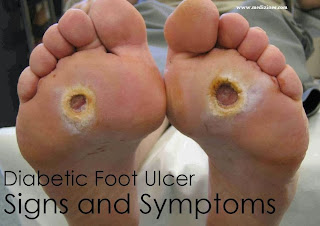One of the complications of diabetes is foot ulcer. It is estimated
that around one out of ten people with diabetes develop a foot ulcer at
some point. Therefore, patients must be aware of the impending
consequences of leaving a diabetic foot ulcer untreated.
When high
blood glucose levels are left uncontrolled for prolonged periods, there
can be damage to various parts of the body. One of the common things
that can develop is foot problems. Even the ones that seem negligible
such as blisters, peeling skin, cracked heels, calluses, and athlete's
foot must be seen and evaluated by a physician.
What are the signs and symptoms of diabetic foot ulcer?
If
the nerves in the foot are functioning well, then the ulcer will be
painful. If the nerves are damaged, pain may not be felt. In this case,
the ulcer may not be noticed, more particularly if it is located on a
less visible portion of the foot.
Sores or blisters are seen on
the foot or lower leg. The diabetic foot ulcer may look like a red
crater or depression in the skin. In more advanced ulcers, it can be
deep enough to expose the tendons or even the bones. Sometimes, the
crater can be bordered by a margin of callused or thick skin.
Difficulty
walking is another sign that may point to foot ulcer. The gait is also
checked by the doctor to see any lower leg abnormalities that can cause
ulcers.
Cold feet means that circulation is impaired.
Discoloration in the feet, such as having purplish or bluish color may
mean ischemia.
Skin changes like cracking, scaling, and excessive skin dryness may mean that circulation to the skin is compromised.
Swollen
feet may also come with diabetic ulcers. This is often accompanied by
tired, aching legs. With chronic venous stasis, the lower legs are
usually edematous and there may be hyper pigmentation of the skin.
Decreased
circulation because of diabetic complications may lead to temperature
changes, either increased warmth or coolness. If there is an ongoing
infection, then the patient may have fever, chills, redness, and the
wound may have drainage.
Diabetic foot ulcers can be serious. They
can take a long time to heal especially if blood glucose levels are not
under control. Foot ulcers can get worse and infections are likely to
occur. Therefore, it is important to get treatment early to avoid more
serious problems. See your podiatrist if you suspect an ulcer has
formed.
By
Lorinne Yen











No comments :
Post a Comment